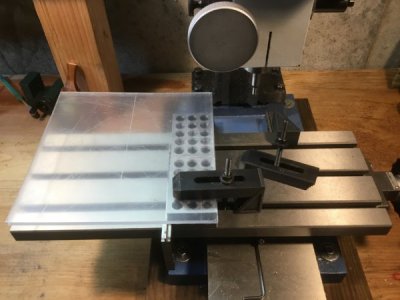Hi All
Every time I search the subject question I get answers on how to cut-to-square a piece.
I already have a piece that is square. It is an 8" square sheet of acrylic by a 1/4" thick.
I want to clamp it onto my 123 blocks and have it square to the table. My dilemma is that I can't first clamp down square the 123 blocks. So for me to do it now I would have to clamp down both items at the same time while trying to make square the 123 blocks with a machinist square and getting one edge of the acrylic sheet parallel to the 123 blocks, thus making the sheet square to the table.
The above method is awkward and difficult.
Any better ideas?
Realize the pic is not how I intend to have it clamped. I just threw in the pieces to get an idea of what I am asking.

Every time I search the subject question I get answers on how to cut-to-square a piece.
I already have a piece that is square. It is an 8" square sheet of acrylic by a 1/4" thick.
I want to clamp it onto my 123 blocks and have it square to the table. My dilemma is that I can't first clamp down square the 123 blocks. So for me to do it now I would have to clamp down both items at the same time while trying to make square the 123 blocks with a machinist square and getting one edge of the acrylic sheet parallel to the 123 blocks, thus making the sheet square to the table.
The above method is awkward and difficult.
Any better ideas?
Realize the pic is not how I intend to have it clamped. I just threw in the pieces to get an idea of what I am asking.

